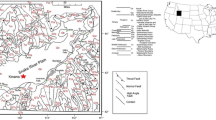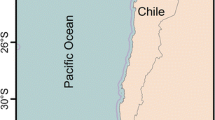Abstract
As part of the International Continental Scientific Drilling Program (ICDP), the 1.5-km-deep borehole Yaxcopoil-1, located in the Chixculub meteor impact structure in Mexico, has undergone further study after drilling operations ceased. Temperature logs were repeated ten times at intervals 0.3–0.8, 15, 24 and 34 months after borehole shut-in. The logs bear a distinct signature of transient heat transfer by groundwater flow manifested by a gradual distortion of the linear temperature profile when a cold wave of 0.8–1.6°C amplitude was detected propagating downward from 145 to 312 m at a rate of 4–6 m/month. To understand the nature of this moving anomaly, a 20-day monitoring of the cold wave was carried out at a depth of 307 m that showed further cooling of 0.6°C during the first 16 days of the passage followed by temperature stabilisation. As an explanation of this unusual phenomenon, a theory is proposed, whereby the drilling mud has accumulated within the overlying and cooler highly porous and permeable karstic rocks during the drilling and migrates downward. The observed migration rate suggests a permeability higher than 10−11 m2. This indicates a high vulnerability to contamination of the only freshwater aquifer in the Yucatan region.
Résumé
Dans le cadre du programme international de forage scientifique continental (ICDP), le forage Yaxcopoil-1 profond de 1.5 km, situé dans la structure d’impact météorique de Chixculub au Mexique, fait l’objet d’investigations depuis que les opérations de forage sont terminées. Des diagraphies de température ont été répétées 10 fois pour les intervalles 0.3-0.8, 15, 24 et 34 mois sur le forage au repos. Les enregistrements montrent un signal distinct de transfert de chaleur transitoire par circulation d’eau souterraine caractérisé par une altération progressive du profil linéaire de température. Une vague de froid d’amplitude de 0.8 à 1.6 °C se propageant en profondeur de 145 m à 312 m à la vitesse de 4 - 6 m/mois a été détectée. Pour comprendre l’origine de cette anomalie en mouvement, la vague de froid a été surveillée pendant 20 jours à la profondeur de 307 m. Un refroidissement de 0.6 °C a été observé les 16 premiers jours du passage puis la température s’est stabilisée. Pour expliquer ce phénomène peu commun, une théorie est proposée, selon laquelle la boue de forage se serait accumulée dans les niveaux supérieurs de roches karstiques très poreuses et perméables au moment du forage, avant de migrer en profondeur. La vitesse de migration observée suggère une perméabilité supérieure à 10-11 m2, indiquant une forte vulnérabilité aux contaminations pour l’unique aquifère d’eau douce de la région du Yucatan.
Resumen
Como parte del Programa de Perforaciones Científicas Continentales Internacionales se han realizado estudios posteriores, después de que las operaciones de perforación terminaron, en el pozo profundo (1.5 km) Yaxcopoil-1 que se localiza en la estructura de impacto meteorítico Chixculub en México. Los registros de temperatura se repitieron 10 veces en intervalos 0.3-0.8, 15, 24 y 34 meses después que se terminó el pozo. Los registros muestran una señal distintiva de transferencia transitoria de calor mediante el flujo de agua subterránea manifestada por una distorsión gradual del perfil de temperatura lineal, cuando se detectó una onda fría de amplitud 0.8 a 1.6 oC propagándose hacia abajo entre 145 m y 312 m a una tasa de 4-6 m/mes. Para entender la naturaleza de esta anomalía móvil se llevó a cabo un monitoreo de 20 días a una profundidad de 307m lo que mostró enfriamiento adicional de 0.6 oC durante los primeros 16 días del levantamiento seguido por estabilización de temperatura. Como una explicación a este fenómeno fuera de lo común se propone una teoría que sugiere que el lodo de perforación se ha acumulado durante la perforación en las rocas suprayacentes kársticas altamente porosas y permeables y que posteriormente ha migrado hacia abajo. La tasa de migración observada sugiere una permeabilidad mayor a 10-11 m2. Esto indica una elevada vulnerabilidad a la contaminación del único acuífero de agua fresca en la región Yucatán.




Similar content being viewed by others
References
Anderson MP (2005) Heat as a ground water tracer. Ground Water 43:951–968
Beck AE, Balling N (1988) Determination of virgin rock temperature. In: Haenel R, Rybach L, Stegena L (eds) Handbook of terrestrial heat-flow density determination. Kluwer, Dordrecht, The Netherlands, pp 59–83
Beck AE, Stegena L, Garven G (eds) (1989) Hydrogeological regimes and their subsurface thermal effects. AGU Monograph 47, American Geophysical Union, Washington, DC
Clauser C, Villinger H (1990) Analysis of conductive and convective heat transfer in a sedimentary basin, demonstrated for the Rheingraben. Geophys J Int 100:393–414
Diment WH (1967) Thermal regime of a large diameter borehole: instability of the water column and comparison of air and water filled conditions. Geophysics 32:720–726
Dressler BO, Sharpton VL, Schwandt CS, Ames D (2004) Impactites of the Yaxcopoil-1 drilling site, Chicxulub impact structure: petrography, geochemistry, and depositional environment. Meteorit Planet Sci 39:857–878
Drury MJ (1989) Fluid flow in crystalline crust: detecting fractures by temperature logs. In: Beck AE, Stegena L, Garven G (eds) Hydrogeological regimes and their subsurface thermal effects. AGU Monograph 47, American Geophysical Union, Washington, DC, pp 129–135
Drury MJ, Jessop AM, Lewis TJ (1984) The detection of groundwater flow by precise temperature measurements in boreholes. Geothermics 13:163–174
Escolero OA, Marín LE, Steinich B, Pacheco J (2000) Delimitation of a hydrogeological reserve for a city within a karstic aquifer: the Mérida, Yucatán example. Landsc Urban Plan 51:53–62
Flores-Márquez EL, Chavez-Segure R, Campos-Enriquez O, Pilkington M (1999) Preliminary 3-D structural model from the Chicxulub impact crater and its implications in the actual geothermal regime. Trends Heat Mass Momentum Transfer 5:19–40
Gretener PE (1967) On the thermal instability of large diameter wells: an observational report. Geophysics 32:727–738
Haenel R, Rybach L, Stegena L (eds) (1988) Handbook of terrestrial heat-flow density determination. Kluwer, Dordrecht, The Netherlands
Hales AL (1937) Convection currents in geysers. Monthly Notices Roy. Astron Soc Geophys Suppl 4:122–131
ICDP (2005) Daily drilling reports. http://www.icdp-online.org/sites/chicxulub/internal/DIS_PROJECT_REPORTS.HTM. Cited 7 Jan 2005
Jessop AM (1987) Estimation of lateral water flow in an aquifer by thermal logging. Geothermics 16:117–126
Marín LE, Steinich B, Pacheco J, Escolero OA (2000) Hydrogeology of a contaminated sole-source karst aquifer, Mérida, Yucatán, Mexico. Geofís Int 39:359–365
NASA (2005) Planetary Photo Journal image #PIA03379 from NASA website http://www2.jpl.nasa.gov/srtm/mexico_radar_images.htm. Cited 14 Jan 2005
Popov Y, Romushkevich R, Bayuk I, Korobkov D, Mayr S, Burkhardt H, Wilhelm H (2004) Physical properties of rocks from the upper part of the Yaxcopoil-1 drillhole, Chicxulub crater. Meteorit Planet Sci 39:799–812
Rebolledo-Vieyra M, Urrutia-Fucugauchi J (2004) Magnetostratigraphy of the impact breccias and post-impact carbonates from borehole Yaxcopoil-1, Chicxulub impact crater, Yucatan, Mexico. Meteorit Planet Sci 39:821–829
Šafanda J, Wilhelm H (1995) Unexpected features of KTB temperature logs and their possible explanation. Sci Drill 5:129–134
Steinich B, Marín LE (1996) Hydrogeological investigations in northwestern Yucatan, Mexico, using resistivity surveys. Ground Water 34:640–646
Steinich B, Marín LE (1997) Determination of flow characteristics in the aquifer of the northwestern peninsula of Yucatan, Mexico. J Hydrol 191:315–331
Stoessel RK, Coke JG (2006) An explanation for brackish groundwaters in the freshwater lens in tropical coastal aquifers: Yucatan example. Gulf Coast Assoc Geol Soc Trans 56 (in press)
Urrutia-Fucugauchi J, Morgan J, Stöffler D, Clayes P (2004) The Chicxulub Scientific Drilling Project (CSDP). Meteorit Planet Sci 39:787–790
Wang K, Shen PY, Beck AE (1989) A solution to the inverse problem of coupled hydrological and thermal regimes. In: Beck AE, Garven G, Stegena L (eds) Hydrogeological regimes and their subsurface thermal effects. Geophysical Monograph 47. American Geophysical Union, Washington, DC, pp 7–21
Wilhelm H, Heidinger P, Šafanda J, Čermák V, Burkhard H, Popov Yu (2004) High resolution temperature measurements in the borehole Yaxcopoil-1, Mexico. Meteorit Planet Sci 39:813–819
Wohlgemuth L, Bintakies E, Kück J, Conze R, Harms U (2004) Integrated deep drilling, coring, downhole logging, and data management in the Chicxulub Scientific Drilling Project (CSDP), Mexico. Meteorit Planet Sci 39:791–797
Woodbury AD, Smith L (1985) On the thermal effects of three-dimensional groundwater flow. J Geophys Res 90(B1):759–767
Acknowledgements
The research was supported by Grant Agency of the Czech Republic as projects 205/03/0997 and 205/06/1181, by the Czech Ministry of Education project LA150 and by the Deutsche Forschungsgemeinschaft within the framework of the ICDP Priority Programme through contracts WI 687/17-1, WI 687/17-2, WI 687/17-3. We are grateful to Prof. Jaime Urrutia-Fucugauchi for his valuable professional and logistic assistance provided during our temperature logs of borehole Yaxcopoil-1. We are indebted to Dr. Alan E. Taylor and two anonymous reviewers for comments which helped us to improve this communication.
Author information
Authors and Affiliations
Corresponding author
Rights and permissions
About this article
Cite this article
Šafanda, J., Heidinger, P., Wilhelm, H. et al. Post-drilling destabilization of temperature profile in borehole Yaxcopoil-1, Mexico. Hydrogeol J 15, 423–428 (2007). https://doi.org/10.1007/s10040-006-0082-8
Received:
Accepted:
Published:
Issue Date:
DOI: https://doi.org/10.1007/s10040-006-0082-8




